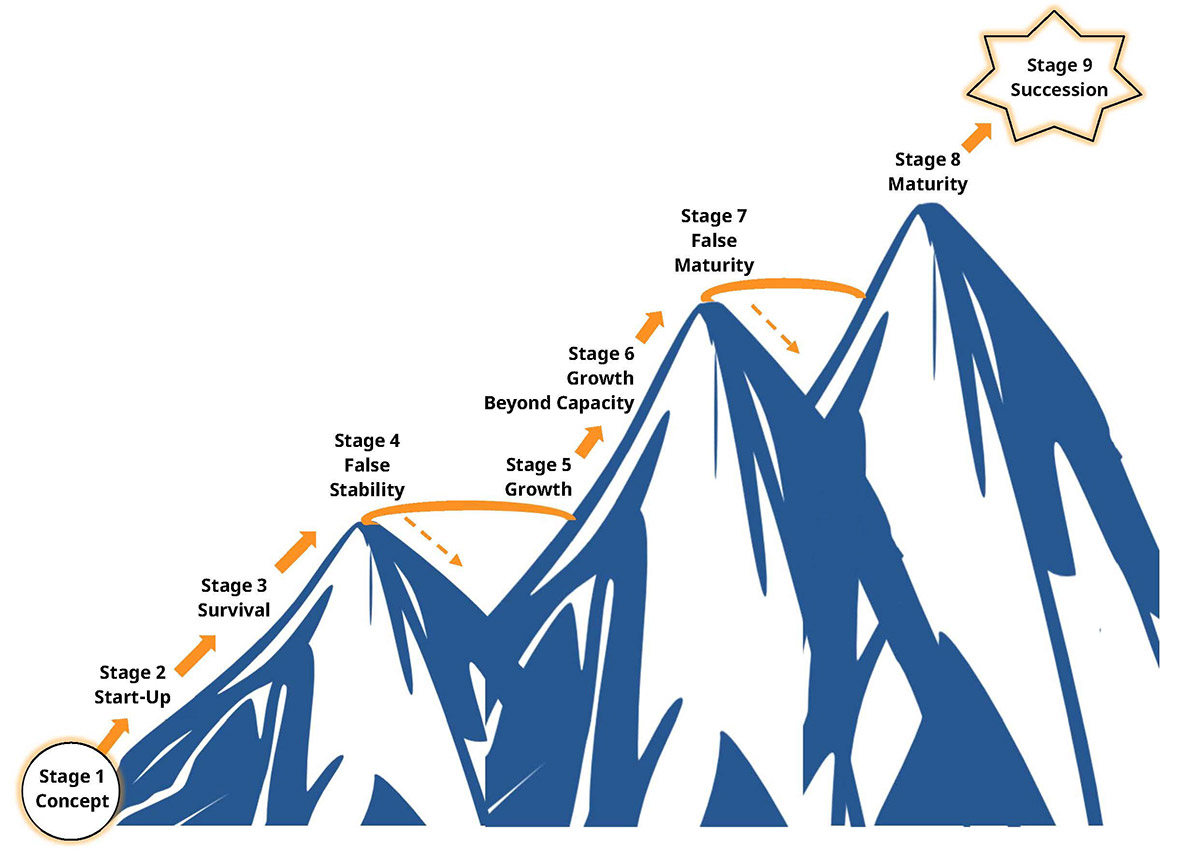Way back when I started my first business (which was not, in fact, when dinosaurs roamed the land; it was just after that), I thought there were only two stages to running a business: You were either broke, or you were really broke.

It seems kind of funny now, but I couldn’t imagine what other options there might be. Even when I got a hint that maybe there was a lifecycle to a business, it was always presented from the point of view of a large corporation: you know, the kind with separate departments for HR, IT, Sales, Logistics. That kind of lifecycle wasn’t relevant to me, or to any other business owners I knew.
I went along like that, figuring that the only measure of success I needed was how broke or really broke I was. Then I came across some work by two Irishmen, John Heenan and Mort Murphy. They proposed that small businesses need their own narrative, one focused on the impact that the life of the small business has on the life of its owners and managers. They called it The 9 Stages of Business “Ownership”—with “ownership” in quotes because, as any small business owner knows, it often feels more like the business is owning you rather than you owning the business.
When I look at it now, it seems obvious: Of course small businesses have a lifecycle different from the lifecycle of large businesses. But I’ve come to realize that it’s only obvious once you’ve seen it, that many small business owners still labor under the misconception that all they need to do to have a healthy, growing business is to be not broke.

Also over the years, I’ve come to see that those nine stages can be broken down into three distinct phases and that each phase is like climbing a mountain: You climb up one slope—taking on the barriers in your path—and when you get to the top, you sit back and enjoy the view and think you’ve gotten to a place of stability. What you don’t always see is the next peak—and the chasm in between you and it. The good news is: If you have a good map (and I’m about to give you one), you can see those false senses of stability coming, and you can build bridges to span the chasms.
Let’s go through these mountains and their stages, one-by-one. As we do, look for yourself and your business in the description and ask yourself Is this where I am?
The First Mountain: Starting at the Bottom
Stage 1: Concept
Stage 1 happens before you even get on the mountain. This is the Concept Stage. It’s pretty exciting: You’ve come up with a cool business idea, and you’re pumped to turn it into reality. You haven’t set foot on the mountain yet; your challenge here is getting your doors open. That’s when things really start to happen.
Stage 2: Start-Up
In Stage 2, you’re still riding that wave of enthusiasm, but now your business isn’t just an idea. It’s real, which means you have to bring in business. You’re also still figuring out how everything works—accounting, licensing, inventory—so there’s a lot of day-to-day pressure.
Stage 3: Survival

By Stage 3, any outside funds you started with are drying up, so the only way to keep your doors open is by bringing in paying clients. This is when quiet desperation sets in, and you think, “I never knew it was going to be this tough!”
These first stages can be a struggle: The slope is steep, and there are a lot of rocky outcroppings in your way. You have to stay focused on bringing in enough business to meet your numbers. That means knowing your numbers: having a clear grasp on your expenses (business and life!), your break-even point and your revenue goals so you know how many appointments you need to schedule and how many sales you need to close to keep going.
It also means having the right tools: 8 to 10 marketing, networking and selling strategies that will bring in business on a regular and consistent basis; a pipeline for cultivating high-quality prospects; and a closing process that works.
Where you might lose your footing is if you decide that any one of those tools isn’t important and you toss it to the side. All of those tools are vital to making it to the peak of your first mountain. If you keep a good grip on them and on that initial energy you brought to your business, you’ll make it to the top in no time.
The Peak of the First Mountain: The Danger of Enjoying the View
You probably had some challenging moments on that first slope: There were times when it felt like it would be a lot easier to go down than keep hiking up. Times when it felt like a scramble. (We all have those times! Check out my blog Don’t Let the Bad Days Get You Down for tips on getting through them.) But now you’ve gotten to the top of the first mountain—and what a view! It’s so good, in fact, that you might think this is the only mountain to climb. That’s why we give Stage 4 a name with a warning.
Stage 4: False Stability

Man, it looks good from up here. You’re generating cash and paying bills. You’re relieved to have survived, and you’re breathing easier. What you don’t notice at first—as you’re inhaling all that cool, crisp mountain air—is that everything in the business depends on you. If you stop, the business stops. You also might notice that you’re bringing in so much business that you’re having a hard time getting all the work done. Not a bad problem to have, but it is something to watch. Your prospect pipeline is dependent in part on happy customers referring you to others, and if you start having fewer happy customers, things are going to fall apart pretty quickly.
You look around, and you see that there’s another mountain to climb. That one leads to growth—but there’s a pretty big gap between you. Don’t worry, though: You can build a bridge to get you safely over it. You need to start delegating.
The Second Mountain: Going Up, Up, Up
Stage 5: Growth
By finding people—the right people—to help you juggle bringing in business and getting the work done, your business is thriving and gaining momentum. You and your team have really hit your stride. (Have a look at my blog Creating an Environment for GREAT Things to Happen for tips on building a great team.) It’s still uphill, but it’s not so much a scramble anymore. You’re drawing income and enjoying the hike. It is true that you’re still very hands-on, and you can’t really step away and take a break; if you do, your team has a tendency to wander from the path and drop their tools. It’s a little hard to keep up the pace, so you start coaching one of your best team members to be a co-guide.
Stage 6: Growth Beyond Capacity
That’s better. Sales and business are still expanding; because you’ve been developing some of your people, you’ve graduated to a “walking around” style of management, and you’re making enough money to support a fulfilling life. At the end of the day, though, everyone still looks to you so you don’t really have the time to enjoy the life you could be living. You feel stuck, like you can’t get out from under the business. You need to think differently about how you build and run your business. You need a new tool: You need systems and processes to build a workplace that empowers employees so you can take a break.
The Peak of the Second Mountain: This Isn’t All There Is
Stage 7: False Maturity

Okay, the view from here is beyond good. It’s awesome! You’ve built a great team that’s bringing in business and getting the work done so well that your business is booming. You’ve got systems in place that simplify and standardize training and procedures so your employees can keep bringing in quality business and providing exceptional service—all without you being there. You cannot imagine what could possibly be beyond this. Though, if you’re going to be honest, you do think about the business when you’re away. You worry; you're not comfortable getting away for that really long trip; you have a tendency to be a little too hands-on sometimes.
We call this stage False Maturity because you feel like you’ve arrived, but you’re really still clinging to the day-to-day processes of your business. It’s totally natural: To lay the mountain analogy aside for a minute, this is your Empty Nester moment. You’ve done a great job raising this business, and it’s time for it to go out on its own. That doesn’t mean it doesn’t need you still; it just doesn’t need you as much. That’s hard, but it is what you’ve been working for: a business that doesn’t own you anymore. You own it.
Let’s get back to the mountain: If you take the next step, if you bridge the gap between the second and third mountains, it is going to open up even more amazing vistas for you.
How do you bridge that gap to the third and final mountain? You trust your team and let go.
The Third Mountain: Letting Go
You’ve done your slogging on the other two mountains. By the time you get to the third, it’s just a little jog to the top. You’ve already put everything in place: Now you need to let everyone do what you’ve been training them to do. You’ll be astonished at how well they do it, but you shouldn’t be. You’ve been preparing them for this moment.
Seriously, though, this can be emotionally tough. Check out my blog Letting Go to Grow for some tips on rocking this third mountain.
The Peak of the Third Mountain: Live Your Life!

Stage 8: Maturity
You’ve made it! You’ve got full-time management in place, you don’t have to worry about the day-to-day and life is rosy. There are so many options! You can finally do what you love in the business. You can keep expanding by franchising or opening new offices. You can work fewer hours. You can take extended time off. You can even get ready to sell or pass your business on to the next generation. Your biggest challenge is figuring out what you want to do with all your freedom and wealth!
(My advice: Don’t wait until then to figure it out! Take time in the early stages to envision what you want your business and life to look like, and you’ll have the motivation and inspiration to make it a reality. Have a look at my blog How to Start Dreaming Again for some tips on setting Life Goals.)
Stage 9: Beyond the Mountain
Most of the small business owners I meet have a hard time imagining giving up their business. Most of us, after all, went into business because we like running a business. We just don’t want it to run us! All the previous stages are about that: running and owning your business in such a way that it doesn’t run and own you. Eventually, though, it will become time for you to leave the business that you’ve poured so much of your heart and soul into. You want to do that right, so that your business remains a living legacy to your hard work and passion. Take a few moments to think about the kind of people who will do that, whether it’s a family member or a trusted manager. Have the image of them in your head as you travel through the other stages, so that when you get here, you will be ready and even excited about passing the torch to them.
Where Are You Now?
The life of a small business owner isn’t a smooth one. We didn’t hop on the freeway of corporate life. We chose a more scenic route. I think it’s a more interesting route. It definitely isn’t a well-mapped one; each of our journeys will look very different.
That’s the power of the 9 Stages: It helps us plot a good course. It helps us see where we are so we can pick up the right tools, so we can reach out and learn from others who have been there, done that. So we can anticipate and maybe even avoid the obstacles over the next rise.
What stage of business “ownership” are you in right now? Where on your mountainous journey are you? What challenges do you face, and what can you do to overcome them? What can you do to reach the third mountaintop?
Get a FREE copy of The 9 Stages e-Book Click Here





































































